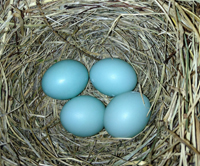 Photo ©
Gerald Clark
Photo ©
Gerald Clark
Rare Bluebird Twins Spark Interest
Earlier this month, we received a report of an anomaly in an Eastern Bluebird nest in State College, Pennsylvania. The nest contained three normal-sized eggs and one large egg. The large egg contained two fertilized embryos, or twins! The four eggs hatched on July 1, resulting in five nestlings. The twins did not grow as quickly as their three siblings and were always noticeably smaller. Unfortunately, these 2 smaller nestlings died after 11 days, perhaps because the adult male bluebird went missing at some point. The female likely had a hard time feeding all five babies on her own, and the two smaller nestlings may not have been able to obtain as much food as their larger siblings. The three surviving nestlings are doing well at the time of this writing.
Twinning has been observed in other species of wild birds, including American Goldfinch, Peregrine Falcon, Gadwall, Mallard, and Song Sparrow, as well as in domestic chickens. Opportunities to observe this rare occurrence outside of a laboratory are scarce because double-embryo eggs are rare to begin with–fewer than half of one percent of waterfowl eggs in one study contained twins. It is even rarer for both chicks to survive hatching. Typically, before hatching, one embryo may out-compete the other, or both embryos may die due to insufficient oxygen and/or space. A large study of 208 double-yolked chicken eggs only resulted in 1 egg that hatched into twin chicks. Twin chicks apparently have a very difficult time pipping the eggshell.
Twins can form from eggs with double yolks (i.e., fraternal twins), or from eggs with one yolk and two embryos (i.e., identical twins). We don’t know which was the case for these bluebird twins, but we do know that for them to have hatched and lived for 11 days is a very rare phenomenon, indeed! We thank Gerald Clark, owner of the nest box in question, and NestWatcher Harry Schmeider for bringing this to our attention so that we can all learn from this unique experience. For further reading about twinning in wild birds, see ornithologist Laura Erickson’s blog post, Twins and Double Yolks in Bird Eggs.
 Photo ©
Photo ©